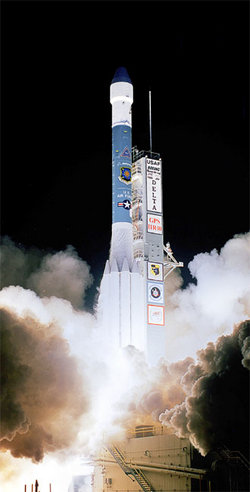Delta II rocket
|
|
The Boeing IDS Delta II family of launch vehicles has been in service since 1989. All United States expendable launch vehicles were to be phased out for the Space Shuttle, but the Challenger accident restarted Delta development. The Delta II, specifically, was designed to accommodate the GPS Block II series of satellites. Delta IIs have successfully launched 115 projects (through August 2004), including the last six NASA missions to Mars:
- Mars Global Surveyor in 1996
- Mars Pathfinder in 1996
- Mars Climate Orbiter in 1998
- Mars Polar Lander in 1999
- Mars Odyssey in 2001
- Mars Exploration Rovers (MER-A and MER-B) in 2003
Deltas are expendable launch vehicles (ELVs), which means they are only used once. Each launch vehicle consists of:
- Stage I: Kerosene and liquid-oxygen tanks that feed the Rocketdyne main engine for the ascent.
- Solid rocket booster motors: Used to increase thrust during the initial two minutes of flight. The medium-capacity Delta II has nine motors total; the newer Med-Lite models use only three or four.
- Stage II: Fuel and oxidizer tanks feeding a restartable, hypergolic Aerojet engine that fires one or more times to insert the vehicle-spacecraft stack into low Earth orbit. This stage also contains the vehicle's "brains", a combined inertial platform and guidance computer that controls all flight events.
- Stage III: Optional solid rocket motor (some Delta II vehicles are two-stage only, and generally used for Earth-orbit missions) provides the majority of the velocity change needed to leave Earth orbit and inject the spacecraft on a trajectory to Mars; connected to the spacecraft until done firing, then separates. This stage is spin-stabilized and has no active guidance control; it depends on the second stage for proper orientation prior to Stage II/III separation.
- Payload fairing: Thin metal or composite shroud (aka "nose cone") to protect the spacecraft during the ascent through Earth's atmosphere.
The Delta II family is more technically named by a four-digit system:
- The first digit is either 6 or 7, denoting the 6000- or 7000-series Deltas. 6000-series have an Extra Extended Long Tank first stage with RS-27 main engine, plus Castor IVA solid rocket boosters. 7000-series have an RS-27A engine, with a longer nozzle for higher expansion ratio and better high-altitude performance, and GEM (Graphite-Epoxy Motor) boosters. GEMs are larger, and have a composite casing to reduce mass versus the aluminum Castors.
- The second digit indicates the number of boosters, usually 9. In such cases, six are lit at liftoff, three lit one minute into flight. Med-Lite vehicles, designated with a 3 or 4, ignite all boosters at liftoff.
- The third digit is 2, denoting a second stage with an Aerojet AJ10 engine. This engine is restartable, for complex missions. Only Deltas prior to the 6000-series used a different engine, the TR-201.
- The last digit denotes the third stage. 0 denotes no third stage, 5 indicates a PAM (Payload Assist Module) stage with Star 48 solid motor, 6 indicates a Star 37 motor.
For example, a Delta 7925 has the later first stage, nine GEM boosters, and a PAM third stage. A Delta 7320 is a Med-Lite with three boosters.
- A Delta II-Heavy has the larger GEM-46 boosters, originally designed for the Delta III. These are designated 7XXXH.
Three payload fairings are available. The original aluminum fairing, seen above, is 2.9 meters in diameter. A 3-meter fairing is made of composite, and can be distinguished by its tapering front and rear. A lengthened 3-meter fairing is used for the largest payloads.
External links
- History of the Delta Launch Vehicle (http://www.kevinforsyth.net/delta/)
Delta_rocket_evolution.png

